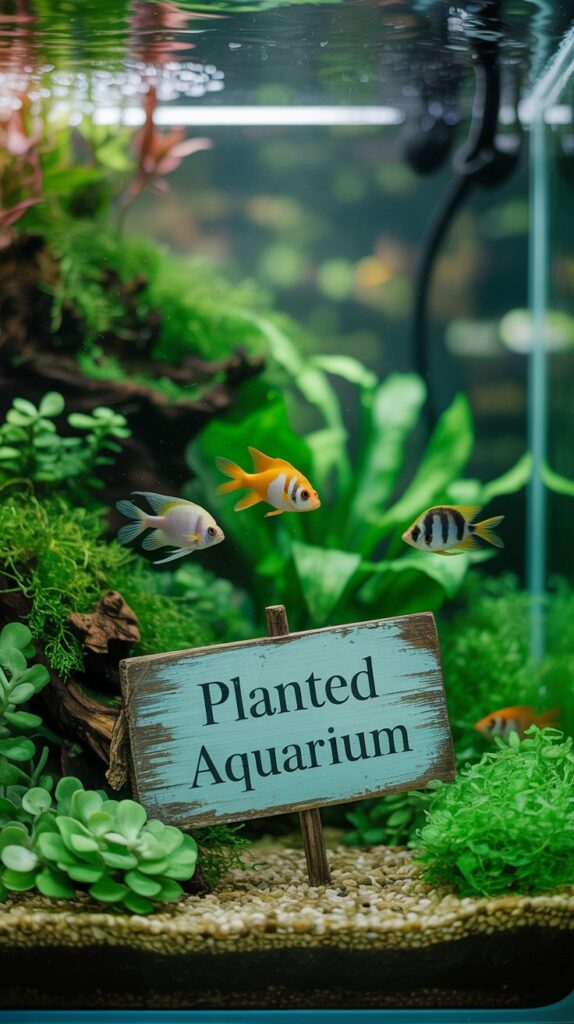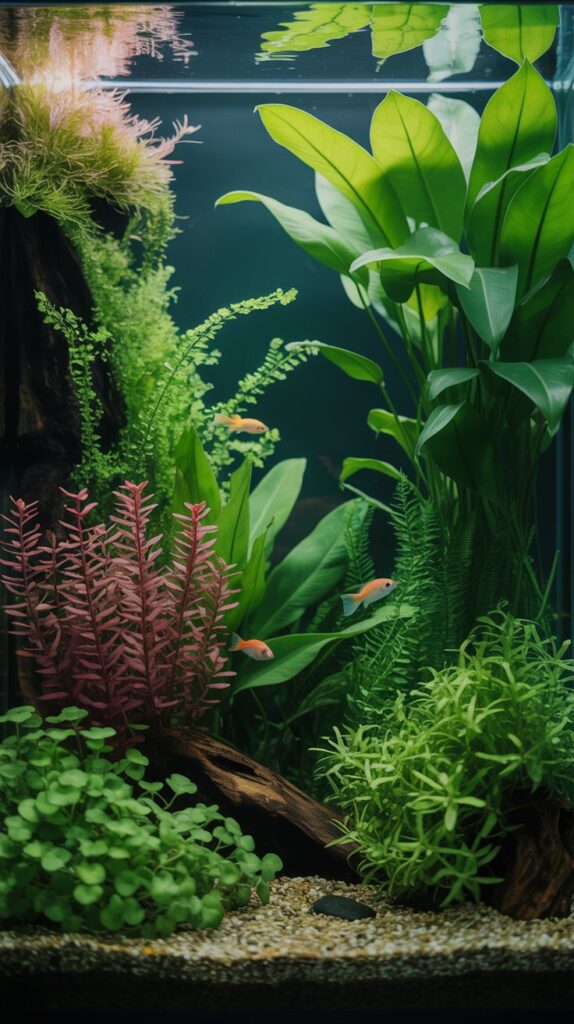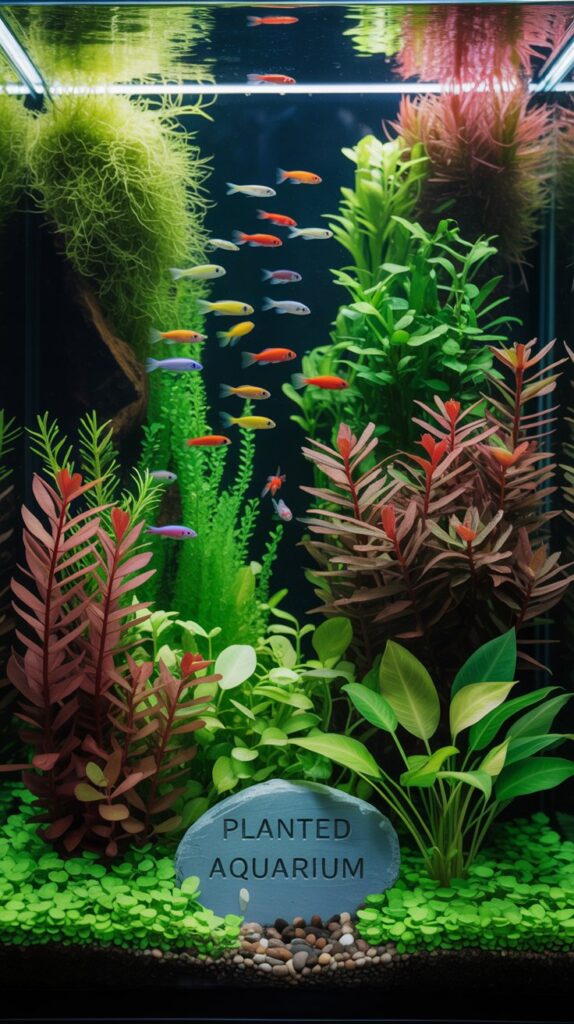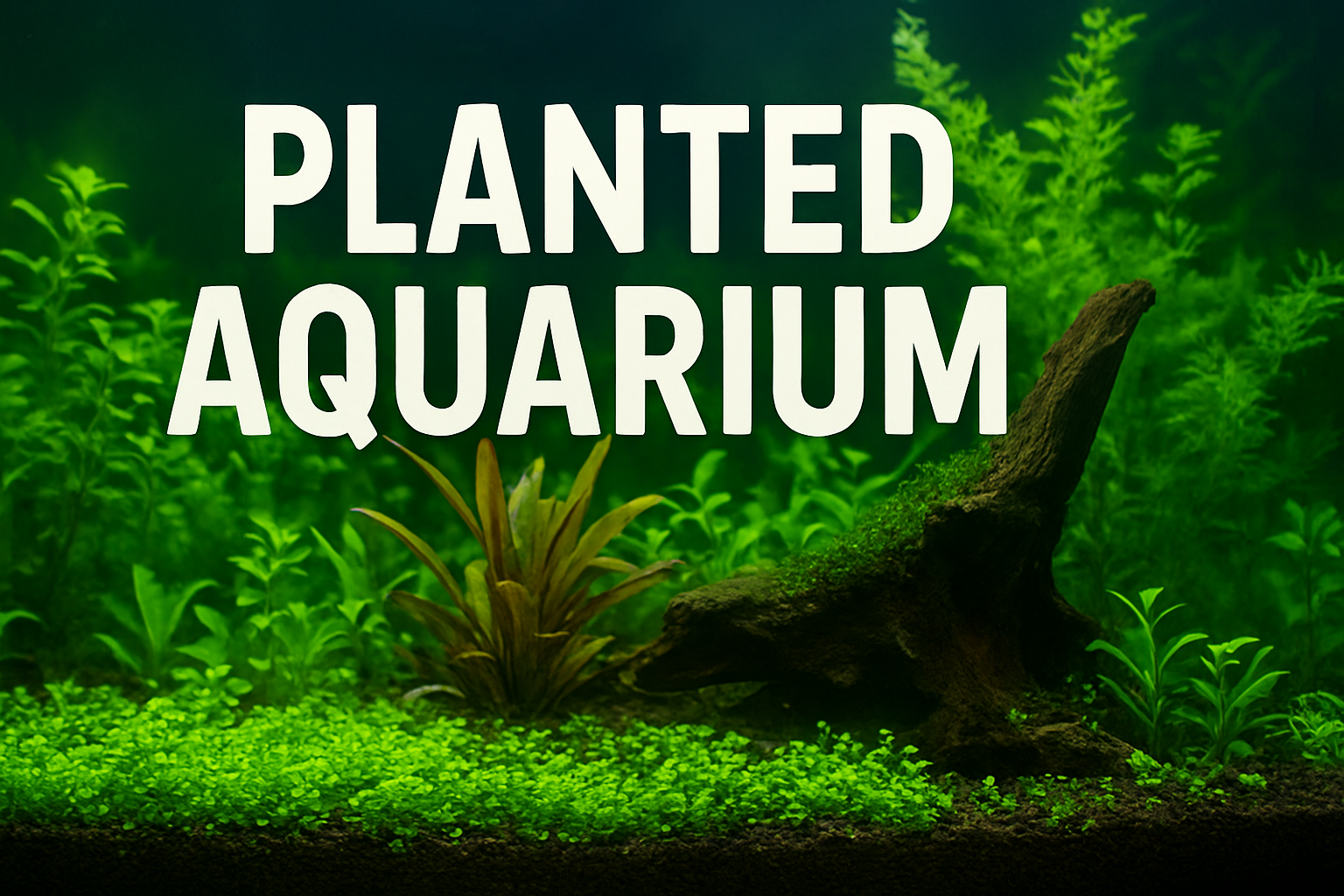A planted aquarium is more than just a fish tank; it is a living ecosystem where aquatic plants and fish coexist in harmony. Unlike a simple aquarium setup, a planted aquarium mimics the natural aquatic environment, offering both beauty and biological balance. From lush greenery to vibrant aquatic species, a planted aquarium creates a captivating underwater world right inside your home.
In this detailed guide, we will explore everything about planted aquariums—types, setup, maintenance, benefits, equipment, aquascaping styles, best plant and fish choices, and answers to frequently asked questions.
What is a Planted Aquarium?
A planted aquarium is an aquarium designed to grow aquatic plants along with fish, shrimp, and other aquatic species. The plants serve as natural filters, oxygen providers, and shelters for fish, creating a balanced environment.

Unlike traditional fish-only aquariums, planted tanks focus on:
- Healthy plant growth
- Aquascaping aesthetics
- Long-term ecosystem stability
Benefits of a Planted Aquarium
- Natural Filtration – Plants absorb nitrates, ammonia, and carbon dioxide, improving water quality.
- Oxygen Production – During photosynthesis, plants release oxygen, which helps fish thrive.
- Stress Reduction for Fish – Plants provide hiding spots and reduce aggression.
- Aesthetic Appeal – A planted tank creates a natural, calming, and beautiful underwater scene.
- Reduced Algae Growth – Healthy plant growth competes with algae for nutrients, minimizing outbreaks.
- Eco-Friendly Hobby – Mimics nature and promotes sustainability.
Types of Planted Aquariums
1. Low-Tech Planted Aquarium
- Uses minimal equipment
- Relies on slow-growing plants
- No CO2 injection needed
- Ideal for beginners
2. High-Tech Planted Aquarium
- Requires CO2 injection and strong lighting
- Demands nutrient-rich substrates
- Suitable for advanced aquascapers
3. Biotope Planted Aquarium
- Replicates a specific natural environment (Amazon, Asian rivers, etc.)
- Includes native plants and fish species
4. Aquascaping Style Tanks
- Dutch Style Aquascaping – Focuses on plant arrangement and color contrast.
- Iwagumi Style – Minimalistic, stone-centered with limited plant varieties.
- Jungle Style – Wild, overgrown look with tall plants and driftwood.
- Nature Aquarium – Inspired by landscapes, mountains, forests, or valleys.
Essential Equipment for a Planted Aquarium
To ensure proper growth and balance, certain equipment is essential:
- Aquarium Tank – Choose according to available space (20–55 gallons is ideal for beginners).
- Lighting – Full-spectrum LED or fluorescent lighting promotes photosynthesis.
- Substrate – Nutrient-rich substrates like ADA Aqua Soil or Seachem Flourite are recommended.
- Filtration System – External canister filters or hang-on-back filters keep water clean.
- Heater – Maintains stable temperature (24–27°C for most plants).
- CO2 System (for high-tech setups) – Boosts plant growth and health.
- Fertilizers – Liquid and root tabs supply essential nutrients.
- Aquascaping Tools – Tweezers, scissors, and spatulas for planting and trimming.
Best Plants for a Planted Aquarium

Beginner-Friendly Plants
- Java Fern (Microsorum pteropus)
- Anubias Nana
- Amazon Sword (Echinodorus amazonicus)
- Java Moss
- Cryptocoryne species
Advanced Plants (require CO2 and high lighting)
- Glossostigma elatinoides
- Hemianthus callitrichoides (Dwarf Baby Tears)
- Rotala rotundifolia
- Ludwigia repens
- Alternanthera reineckii
Best Fish for a Planted Aquarium
Fish play an important role in balancing a planted aquarium. Choose species that are plant-friendly and peaceful.
Ideal Fish
- Tetras (Neon, Cardinal, Ember)
- Rasboras
- Guppies
- Dwarf Gouramis
- Corydoras Catfish
- Otocinclus Catfish
- Cherry Shrimp & Amano Shrimp
Fish to Avoid
- Goldfish (they uproot plants)
- Large Cichlids (they dig and destroy aquascapes)
- Plecos (can damage delicate plants)
Step-by-Step Guide to Setting Up a Planted Aquarium

Step 1: Choose the Tank Size
Bigger tanks are more stable and easier to maintain.
Step 2: Select the Substrate
Use nutrient-rich soil or a layered substrate system with gravel on top.
Step 3: Install Equipment
Place filter, heater, and CO2 system before filling water.
Step 4: Plan Your Aquascape
Decide on a style (Dutch, Jungle, Iwagumi, etc.) and layout hardscape (rocks, driftwood).
Step 5: Planting
Use tweezers to carefully place plants according to size:
- Foreground – carpeting plants like Dwarf Hairgrass
- Midground – medium plants like Cryptocoryne
- Background – tall plants like Amazon Sword
Step 6: Fill with Water
Slowly fill the aquarium with dechlorinated water to avoid disturbing the substrate.
Step 7: Cycling
Run the tank for 4–6 weeks to establish beneficial bacteria before adding fish.
Step 8: Introduce Fish and Shrimp
Gradually add livestock to avoid sudden spikes in water parameters.
Maintenance of a Planted Aquarium
- Water Changes – 20–30% weekly to keep nutrients balanced.
- Trimming Plants – Prevent overgrowth and maintain aesthetics.
- Monitor CO2 Levels – Too much CO2 can harm fish.
- Fertilization – Dose liquid fertilizers regularly.
- Check Lighting Duration – 8–10 hours daily; too much light causes algae.
- Clean the Filter – Monthly cleaning ensures efficient performance.
Common Problems in Planted Aquariums
- Algae Overgrowth – Caused by excess light or nutrients.
Solution: Balance light, CO2, and nutrients; add algae-eating fish/shrimp. - Plant Melting – Common in Cryptocoryne species after relocation.
Solution: Give time to adapt; avoid frequent replanting. - Yellowing Leaves – Indicates nutrient deficiency.
Solution: Add fertilizers containing iron and potassium. - Slow Growth – Caused by low CO2 or insufficient lighting.
Solution: Improve lighting and inject CO2 if needed.
Tips for a Successful Planted Aquarium

- Always research plant and fish compatibility.
- Avoid overstocking fish to maintain balance.
- Choose hardy plants if you are a beginner.
- Use aquascaping tools for precision planting.
- Be patient—plants take weeks to months to fully establish.
Advanced Aquascaping Techniques
- Dry Start Method (DSM): Grow carpeting plants in a moist environment before filling the tank with water.
- Hardscape Balance: Use rocks and driftwood to create natural depth and perspective.
- Golden Ratio Layout: Position focal points at 1/3 or 2/3 of the tank for natural aesthetics.
- Layered Planting: Arrange plants by height and color contrast for visual appeal.
Conclusion
A planted aquarium is more than just a hobby—it’s an art form and a miniature ecosystem. Whether you prefer a simple low-tech tank or a complex aquascape with CO2 injection, the joy of watching plants and fish thrive together is unmatched. With proper planning, equipment, and care, anyone can create a thriving underwater paradise at home.
FAQs About Planted Aquariums
Q1: Do planted aquariums need CO2?
Not always. Low-tech tanks can thrive without CO2, but high-tech setups with demanding plants benefit greatly from CO2 injection.
Q2: How many hours of light do aquarium plants need?
Most aquatic plants need 8–10 hours of consistent lighting daily.
Q3: Can I use regular soil in a planted aquarium?
Regular garden soil is not recommended as it may release harmful substances. Use aquarium-specific substrates instead.
Q4: What is the best beginner plant for a planted aquarium?
Java Fern, Anubias Nana, and Amazon Sword are excellent beginner plants.
Q5: How long does it take for a planted aquarium to cycle?
It usually takes 4–6 weeks for beneficial bacteria to establish.
Q6: Can goldfish live in a planted aquarium?
Goldfish are not recommended as they uproot and eat plants.
Q7: How often should I fertilize a planted tank?
Most setups require weekly liquid fertilizer dosing, depending on plant density.
Q8: What fish help control algae in planted aquariums?
Otocinclus catfish, Amano shrimp, and Siamese algae eaters are great algae controllers.

